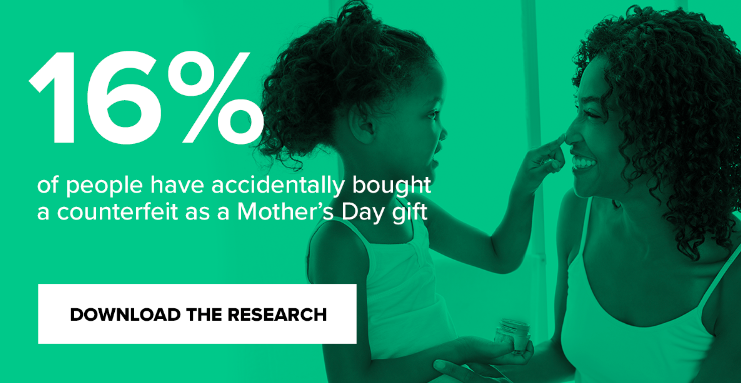
Table of Contents:
Last updated on: June 8, 2022
Mother’s Day has become a huge cultural and commercial event in The United States in recent years, and this is especially true for beauty brands. But counterfeiters have taken notice and have jumped on the trend.
Mother’s Day is celebrated by 86% of Americans, constituting an enormous 281 million people. Its importance is especially clear on social media, generating photo and video uploads from over a billion people. It’s also become a vital time for brands in a range of industries, with shoppers spending $23.1 billion on the event in 2018, making it the third-largest retail event in the US.
Mother’s Day is an essential time of the year for beauty brands, Red Points’ conducted market research to better understand the holiday’s effect on beauty brands and counterfeits. As seen in the graph below, more than 27% of consumers are considering purchasing beauty products for the event, making it the third most common consumer product after jewelry and clothing.
Social media is an especially important channel for beauty brands. Not only are 31% of MDAY sales made online, but Red Points’ research shows that 34% of respondents say social media posts by brands affect their decision to purchase cosmetics. Also, 31% are affected by advertisements on social media and 24% by “influencers” (individuals who their social media profiles with huge numbers of followers to advertise and promote certain products).
Social media and the beauty industry really is a match made in heaven. With an estimated 2.7 billion users, social media has quickly become the main source of content for internet users, meaning beauty brands have a huge target audience to reach. On top of this, social media also:
This strategy is paying off within the industry. The research shows that nearly 62% of respondents have purchased beauty products from social media at one point, either through adverts, posts or even through links found in comments.
Unfortunately, counterfeiters understand these trends, too – they’ve adopted social media massively in recent years as their own sales channel. Internal detections data from Red Points shows that Facebook and Instagram combined account for 30.2% of all confirmed intellectual property (IP) infringements, with only eBay (29.8%) and Wish (17.1%) coming close to that level.
The research showed more worrying conclusions. 16.7% of respondents claimed to have bought a fake for Mother’s Day. This number rises to 33.7% when asked about items bought online. Of this second group, nearly half of all the fake products came from either Instagram or Facebook.
Not only that, counterfeiters also understand the importance of Mother’s Day for the sale of beauty products. Red Points sees IP infringements grow sharply on both Facebook and Instagram in the run-up to Mother’s Day, with a clear peak in May. This demonstrates how aware counterfeiters are of consumers’ trends and shopping habits, and how quick they are to adjust their strategies to sell their products.
The sale of these products is not only harmful to brands but of course, proves a real danger to consumers. These fake cosmetics don’t adhere to safety standards that authentic brands do, and are more concerned about creating a product that mimics the look of the real deal at the lowest possible cost. This leads to extremely dangerous ingredients being included in their recipes, including lead, which can cause human developmental toxicity among other things; arsenic, which leads to system toxicity throughout organs in the body; and even urine, animal feces, and paint stripper.
These findings should be alarming for any brands in the beauty industry. One question from this research showed that 84% of respondents would be wary about buying products from a brand if they had purchased a counterfeit of the brand in the past. This means counterfeiters are not only taking sales from these companies, at one of the industry’s most important annual events, but brands suffer doubly as their reputation also takes a hit.
Furthermore, social media users participate in notably risky habits online. 60.3% of respondents said they would be willing to click on a social media post that offered discount beauty products, even if they weren’t familiar with the seller. Previous Red Points research has shown how easy it is for counterfeiters to set up social media profiles, and then link users to online marketplaces or even rogue websites that sell counterfeit products.
Brands have been recommended to educate their customers on the risks of counterfeit beauty products, both as a way of keeping their fans safe from the dangers of fakes and for protecting their own brand image.
The full market research takes a closer look at these findings, with more in-depth analysis into each point discovered. The research also covers a number of other issues, including the greater risk that 18-29 year olds face from counterfeiting operations on social media. This trend stems from young users’ marked increase in daily social media use, as well as riskier habits on social media, such as the higher probability of clicking on offers from unknown sellers and other factors.
The full research is available for download for free simply by clicking the image below.
